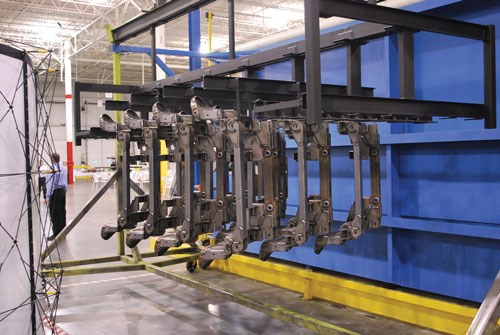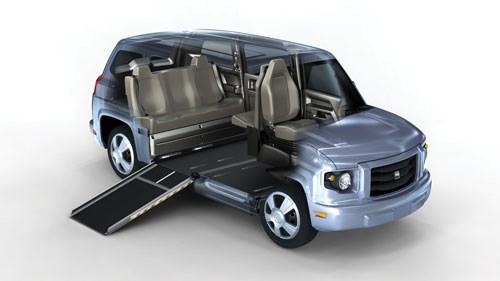Co-Cure to the Rescue For A-Coat and Powder Coating
Henkel’s autodeposition protection technology is an alternative vehicle coating, as Android hopes to produce 9,000 vehicles this year for Florida-based Vehicle Production Group.
#automotive
Mike and Cathy Frazure of Ann Arbor, Mich., have been waiting a long time for a car like those made at Android Industries in Flint.
It’s not sporty or flashy, nor is it anything close to luxurious. It simply works beautifully for their 27-year-old daughter, Emily, who uses a wheelchair and will benefit most from Vehicle Production Group’s first vehicle specifically designed for the disabled, the MV-1.
Featured Content
“What’s perfect for us is that it will be much easier for her to enter the vehicle with the built-in ramp while it’s still in the garage, without having to go out into the cold and ice,” Mike Frazure said during a media gathering at the Android facility, which assembles and coats most of the vehicle components before shipping them off to Indiana for final assembly.
Fred Drasner, chairman and CEO of Vehicle Production Group, says the new vehicle is safer because it is designed from the ground up, and not a vehicle that has been modified and cut and welded back together.
“For millions of disabled Americans, the only mobility alternative to the MV-1 is to buy a standard automobile and then pay thousands in retrofitting costs, compromising its design integrity,” Drasner says. “The MV-1 is truly revolutionary: a wheelchair-accessible car that is designed from the ground up to meet or exceed ADA guidelines.”
Android hopes to produce 9,000 of the vehicles this year for Florida-based Vehicle Production Group, including applying Aquence, an eco-friendly, rust-preventative coating from Henkel, to the frame, engine cradle and various structural cross members.
In fact, the Android plant boasts the largest Aquence coating line in North America at nearly 22,000 gallons, says Michael Berger, Henkel’s business development manager for coatings. The coating product won the 2010 Automotive News PACE Award for innovation and performance.
Henkel Corporation says it developed the autodeposition process as an alternative to e-coat for the anti-corrosion coating of vehicles and parts. After low-temperature drying, a topcoat is applied and both coats are cured and cross-linked in a single drying oven.
“Aquence’s water-based process has 90 percent less volatile organic compounds, and its improved edge coating is 20 times better coverage than an e-coat application,” Berger says.
Up to 40 Percent Lower Capital Cost
The Android line in Michigan is a showcase for the ability of Henkel’s Aquence coating process, and Berger says the process, in turn, was ideal for Android because of the powder topcoating. He says it uses less paint, less energy and less floor space, and gives better corrosion resistance than comparable wet-on-wet processes using an e-coat base. It also offers nearly 40 percent lower capital cost.
“The ability to mix polymers in the emulsion used for deposition gives superior corrosion resistance,” Berger says. “Any surface that is wetted is coated, which, with the right paint formulation, gives better corrosion resistance in holes, on edges and in odd-geometry cavities.”
Android worked with Henkel and Parker Ionics in Westland, Mich., to help design the “co-cure” system, with Parker Ionics installing a large powder coating booth and equipment. The biggest challenge was putting in a powder coating system that could coat after the Aquence sequence, but Parker Ionics’ John Cole spent several months working with Android engineers to get it right.
“We needed to get the highest transfer rate possible because of the existence of the primer coating,” says Cole, who used his company’s “Pulse Power” system, a technology that charges powder using high voltage (100 kV) and low current (~10 uA) through the use of “Pulse Width Modulation.”
Cole says the booth and gun system is designed to vary the duty cycle (on time vs. off time) and optimize the current flow for better Faraday cage penetration and the higher transfer efficiency needed.
The booth Parker Ionics installed is 26 ft long, 14 ft tall and 10 ft wide. Fostoria Process Equipment Div. of TPI Corp. installed the curing oven for the system, and AkzoNobel supplied the powder coating.
Developed in the 1960s
The Henkel technology was invented in 1969 by Wilbur Hall and Lester Steinbrecher of Amchem Products in Pennsylvania, but the first generation did not hit the market until 1974.
Henkel first introduced the co-cure process at Valley Towing Products in Lodi, Calif., using the Aquence 930 autodeposition coating and a powder topcoat application to coat towing systems such as hitches and fifth wheels for automotive OEM and aftermarket applications.
“This game-changing technology will reinvent the total automotive paint shop,” says Chuck Evans, executive vice president for automotive at Henkel. “It reduces energy requirements, eliminates stages and contains no heavy metals.”
In Germany, companies like Räckers and BBL have opted for the non-electric technology from Henkel because it was a sustainable coating process that did not have hazardous heavy metals.
Räckers decided in late 2008 to expand its production facilities by adding a high-quality corrosion protection coating line. The comprehensive scope of this systems supplier of commercial vehicle technology covered a variety of methods for producing vehicle superstructures, including metal processing, CNC cutting and the use of modern foaming and adhesive technologies.
While the company initially considered installing a classic e-coating line with metal pretreatment, Räckers finally decided on an Aquence coating system in combination with a downstream powder coating stage.
“This process for coating ferrous metals is purely chemical and offers a number of decisive advantages,” says Claus Räckers, the company’s CEO. “Foremost among these is the absolutely uniform, 100 percent coating of components or assemblies.”
Räckers says his company’s tests showed that even poorly accessible areas, cavities, or sharp corners and edges could be provided with a continuous layer of corrosion protection, and that there were none of the restrictions associated with the Faraday effect.
“As a component manufacturer for commercial vehicles, full corrosion protection on all exterior and interior surfaces is a crucial performance feature for us and our customers,” says Räckers, who decided on the Aquence autodeposition process because it can provide long-term corrosion protection on complex tubular and pre-assembled components with intricate geometries and lengths of up to 8 m.
Chemical Instead of Electrical
The Aquence process differs from classic e-coating in that it requires no metal pretreatment and no electricity to form the coating. Through a chemical reaction in a bath of polymer emulsion, an organic layer is formed on the degreased metal surface. A mild acid releases divalent iron ions, which then combine with the paint particles in the solution and re-bond with the surface of the substrate so that each ferrous area of the component is uniformly coated in the desired thickness, while leaving plastic parts uncoated.
Berger says this makes it possible not only to coat complex structures evenly inside and out, but also to process complete assemblies consisting of different materials.
The immersion coating line has been in operation at the Räckers production site in Ahaus, Germany, for more than a year, and its corrosion protection and toughness has convinced Räckers.
“In our lab tests, the process easily achieved 1,000 hours in the neutral salt spray test,” he says.
The coating concept comprises just seven baths. After a four-stage cleaning and rinsing sequence, chemical deposition takes place in the Aquence bath directly on the degreased substrates. The two-stage post-rinse removes any chemical residues from the parts.
“Compared to the e-coat process, the investment costs are about 20 percent lower,” says Eric Ardourel, technology manager for Europe at Henkel. “At the same time, the line has a smaller shop floor footprint, partly because the usual phosphating or chromating steps are not required, and also because the oven size can be much smaller than for e-coating.”
The process is also free of any toxic heavy metals such as zinc or nickel, and generates practically no VOC or hazardous sludge, all of which significantly reduces waste generation and disposal costs.
Co-Cure Process
Another positive effect on the overall process costs is the fact that it consumes less energy. Besides needing no electricity to produce the reaction in the coating bath, energy savings are also achieved due to the lower bake temperature in the subsequent two-zone ovens.
“The coated components are first dried at just 140°F, then briefly pre-baked at 284°F. This naturally also shortens the time it takes the parts to cool down before the topcoat is applied,” Berger says.
About 95 percent of all parts at Räckers are powder coated. Crosslinking of the Aquence primer and the powder coating is performed in the same oven, also at a reduced temperature of some 338°F.
“In addition to improved energy efficiency, our tests have shown that thanks to the co-cure process, the inter-coat adhesion is enhanced, thus improving mechanical performance,” says Berger, pointing to the advantages of being able to cure both coatings in one step.
Sustainable Coating Strategy
The first Aquence co-cure line in Germany went into operation in BBL Oberflächentechnik in Nürnberg in 2007. The company specializes in job-coating and surface treatment for various clients. Aside from various blasting operations, their product portfolio comprises a wide variety of coating solutions for part weights up to 20 tons.
To complement their existing production lines, the company was looking in 2007 for a high-quality, environmentally benign corrosion-protection method with zero hazardous heavy metals that would also overcome the shortcomings of e-coating, primarily regarding its limited cavity coating capability.
Today, steel parts weighing as much as 1,000 lbs are coated at BBL using the Aquence system.
“Thanks to continuous bath maintenance, the system produces no wastewater at all,” says BBL CEO Robert Lumpi, who says the dip tank can accommodate parts with a size of up to 3,000 × 1,600 × 800 mm.
Moreover, Lumpi says the low VOC content eliminates the need for post-combusting emissions, and the fact that complete assemblies can be coated provides logistical benefits by reducing the number of transports and simplifying warehousing.
He says the high degree of automated chemical dosage reduces the need for manual maintenance and control, and that the compact yet very flexible line design allows the use of Aquence as a co-cure primer in combination with various powder coatings and as a highly resistant stand-alone single-layer coating with outstanding mechanical properties.
For information on Henkel’s Aquence, please visit Henkel.com/aquence-autophoretic-12623.htm. For information on Parker Ionics, please visit Parkerionics.com or call 734-326-7630. For information on Fostoria Industries, please visit Fostoriaindustries.com or call 800-495-4525. For information on AkzoNobel, please visit Akzonobel.com.
RELATED CONTENT
-
Coatings Drive Electric Vehicles Further
Electric vehicle batteries depend on coatings to maintain optimal temperatures, reduce the risk of fire damage and electrical interference, and more.
-
An Introduction to Cyclic Corrosion Testing
A more realistic way to perform salt spray tests.
-
Applications Innovation Leads to Better Masking Solutions
When masking product failures are costing you money, it pays to work with an expert that can select or engineer the most efficient solution.






















